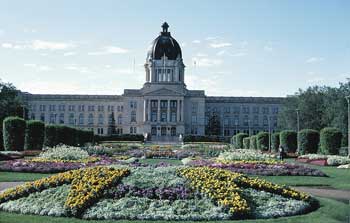ABOUT Saskatchewan
 Located in between the Canada's three prairie provinces, Saskatchewan is in the shape of a quadrilateral that borders Alberta on the west, Northwest Territories on the north, Canadian province of Manitoba on the east and American states of Montana and North Dakota on the south.
Located in between the Canada's three prairie provinces, Saskatchewan is in the shape of a quadrilateral that borders Alberta on the west, Northwest Territories on the north, Canadian province of Manitoba on the east and American states of Montana and North Dakota on the south.
Saskatchewan smells of the various good quality crops such as barley, wheat etc. The province is characterized by flat and featureless expanse of prairie. The northern part of the province is dominated by lakes and forests. Fishing and camping are the favorite activities of visitors in this region.
Lofty hills and beautiful big parks and aspen groves can be found in the central parkland area of the province. In summers the place is ideal for trail riding while during winters skiing is the best sport to enjoy.
The southern half of the province is a part of the Great Plains. This part offers extensive landscapes and a diverse topography. Main attractions are the museums here such as the Weyburn museum that presents largest collection of silver wares in North America along with archaic artifacts that date back to the pre- Victorian England era, the museum of the Maple Creek, Fur Carlton, a living museum for fur trade etc. Apart from the lovers of history, due to an incredible variety of wild animals and birds, wildlife aficionados can also have a great time in the province of Saskatchewan.
The capital of the province is the beautiful and young city of Regina. Regina is an important city in the southern third of the Canadian province of Saskatchewan. Regina is one amongst the most lively and exciting places in entire Canada. Due to approximately 2,365 sunshine hours each year, Regina is also known as the Canada's sunniest capital.
The city takes pride in being the land of some of the great and potential Canadian artists. It is also the home of the famous Royal Canadian Mounted Canadian Police. Regina is also known for the Regina Plains Museum, the Assiniboia gallery, delicious cuisine and some great resorts.
The history of this province reveals its archaic origins. The land was first inhabited by the Algonkian, Iroquoian, Pooland and Inuit groups. The name Quebec is believed to have been derived from the Algonquin language wherein it means "strait" or "narrowing".
The largest city of Saskatchewan is Saskatoon. The city is located in the central Saskatchewan, on the south of the Saskatchewan River. Saskatoon is also the most populated city of the province.
Also known as the Hub City or the City of Bridges, for its seven-river crossing, Saskatoon is a thrilling city that offers great sources of entertainment such as recreational activities, magnificent museums, pulsating nightlife, huge theaters and festivals.
Pondering over the past of the province we get to trace its archaic and interesting origins. For a long time the Athabaskan, Algonquian and Sioux tribes dominated over the land. These tribal people had brought their own culture and customs to the place. But soon they were replaced by the European settlers.
Henry Kelsey was the first European to enter the Saskatchewan region. He came here in 1690 with the aim of fur trading with the local people.
The foremost permanent settlement was a Hudson's Bay Company post at the Cumberland House which was founded by Samuel Hearne, an English explorer in 1774. In the later years there were other explorations in the region too.
Around 1880 the Northwest Mounted Police established several posts and forts across the Saskatchewan region. Gradually the influx of people increased in this region as a result of which on 1st September 1905, Saskatchewan was formally declared a province of Canada.
Canadian Based Sites (Click)